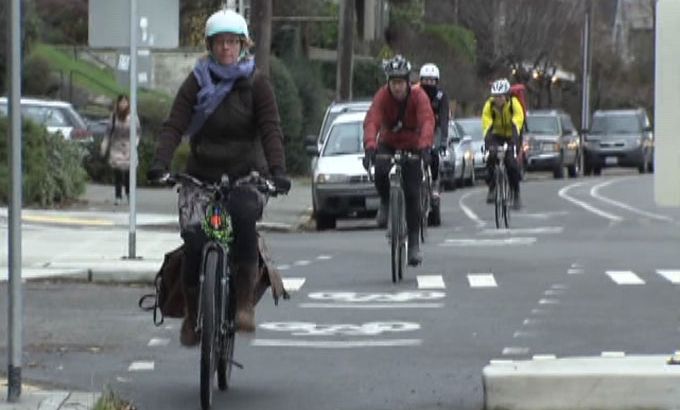Cycling is indeed becoming more popular globally, driven by increasing health consciousness and diverse applications such as commuting, exercise, sports, and hiking. The global bicycle industry is experiencing remarkable growth to cater to this expanding demand with various bike categories like mountain bikes, road bikes, and hybrid bikes.
As driving has decreased over the past two decades, the number of cycling trips has quadrupled, indicating a significant shift towards cycling as a preferred mode of transportation. Bicycles are now being viewed as a socially distant and healthy alternative for essential workers and commuters, contributing to the surge in their popularity.
With cycling offering a great workout and promoting good health, its popularity continues to rise as a sustainable and enjoyable means of travel.
Historical Trends
Looking back, cycling has seen a big jump in popularity, especially during and after the COVID-19 pandemic. In the US, the number of people riding bikes at least once in 2022 hit 54.7 million, up from earlier years.
In the UK, while there was a dip after the pandemic peak, participation is still higher than before 2020. Globally, the bicycle market was worth USD 77.01 billion in 2024 and is expected to grow at 9.9% annually until 2030. This shows a clear upward trend, with sales and interest staying strong.
A Growing Global Trend
Across the world, more people are turning to bikes for their daily travel. City streets once crowded with cars now see an increase in cyclists. Urban areas are now rethinking transport systems. Local governments are adding bike lanes and improving paths. This change makes cycling safer and more appealing.
During the pandemic, many people looked for safe ways to move around. Bicycles provided a healthy option that allowed individuals to maintain social distancing. Many cities reported a jump in cycling numbers. This change is not just a temporary trend; it is shaping the future of urban travel.

Credit: www.aljazeera.com
Health and Well-Being Benefits
One of the main reasons behind cycling’s growing popularity is its health benefits. Riding a bike is a simple and fun way to get exercise. It improves heart health, builds muscle, and boosts mood. Cycling helps reduce stress and makes people feel better overall.
In our busy lives, finding time to exercise can be hard. A bike ride can fit into daily routines with ease. People can cycle to work or run errands. This dual purpose of transportation and exercise makes cycling an attractive option. It is easy to start, and the benefits are quick to notice.
Environmental Advantages
Cycling is good for our planet. Cars and buses release pollutants into the air. These emissions contribute to climate change. Bicycles, on the other hand, do not pollute. By choosing to cycle, people help reduce air pollution and lower their carbon footprint.
Cities that promote cycling also benefit from less traffic congestion. With fewer cars on the road, there is less noise and fewer traffic jams. Cleaner air and quieter streets make urban areas more pleasant to live in. These environmental benefits are key reasons why many governments now support cycling initiatives.

Credit: www.bbc.com
Economic Impact of Cycling
Cycling does not only bring health and environmental benefits; it also has a positive economic impact. When more people choose to cycle, cities see a reduction in traffic congestion. This decrease leads to lower fuel costs and less need for expensive road maintenance.
Local businesses also gain when cyclists come through town. People on bikes are more likely to stop and shop in small stores. They enjoy the slower pace and the chance to explore local shops and cafes. The boost to the local economy is noticeable, and it can lead to a more vibrant community.
Changing Attitudes and Lifestyle
Modern lifestyles are changing, and so are attitudes toward travel. Many people now seek a balance between work and personal life. Cycling fits well into this new lifestyle. It offers a chance to disconnect from the stress of daily routines and enjoy a moment of freedom.
Cycling also promotes a sense of community. In many cities, cycling groups and clubs have formed. Friends meet for weekend rides and share tips on the best local routes. This social aspect makes cycling more than just a way to get from one place to another. It becomes a part of a healthy, active lifestyle.
The Role of Technology
Technology is also driving the cycling trend. New innovations in bike design and safety gear have made cycling more accessible. Electric bikes have been one of the biggest trends in recent years. They allow riders to cover longer distances with less effort. This innovation helps people who are new to cycling or those who need extra help on hilly terrains.
Smart apps have also made a difference. These apps help cyclists plan routes and track their rides. They provide real-time updates on traffic and weather. This technology makes the experience smoother and more enjoyable. With better tools at their fingertips, more people feel confident about cycling.
Urban Planning Improvements
Cities are increasingly investing in cycling infrastructure, with examples like Copenhagen and Amsterdam leading the way. These cities boast extensive bike lane networks, contributing to high cycling rates, as noted in the Bicycle Cities Index 2020 [7]. Urban initiatives, such as bike-sharing programs, further enhance accessibility, encouraging more people to cycle for daily commutes.
Enhanced Infrastructure and Safety
Safety is a top priority for anyone on the road. To support the growing number of cyclists, many cities are investing in better infrastructure. New bike lanes are being built, and existing ones are being improved. These dedicated paths help separate cyclists from car traffic.
Improved lighting, clearer road signs, and safer crossings are all part of this push. When cyclists feel safe, they are more likely to choose biking over driving. Cities that invest in cycling infrastructure also see fewer accidents. This improvement is a clear sign that cycling is not just a trend—it is becoming a key part of urban planning.
Social Media and Community Engagement
Social media has a big impact on the way trends spread. Today, many cycling enthusiasts share their experiences online. They post photos of scenic routes and tips for safe riding. These posts inspire others to pick up a bike and join the movement.
Online groups and forums allow cyclists to connect. They share advice and support one another. This sense of community encourages more people to try cycling. As the stories spread, cycling becomes a shared experience that draws more fans every day.
Challenges and Obstacles: Barriers to Further Growth
Despite its popularity, several challenges could limit cycling’s expansion, each requiring attention to sustain momentum:
- Safety Concerns: Safety remains a significant barrier, with fear of accidents deterring potential cyclists. In 2020, the National Highway Traffic Safety Administration reported 938 cyclist deaths in the US, underscoring the need for improved road safety measures. Enhancing cyclist safety through better infrastructure and education is crucial to boost confidence.
- Lack of Proper Infrastructure: Many regions lack dedicated bike lanes, making cycling less safe and convenient. The League of American Bicyclists highlights that cities with robust cycling infrastructure see higher participation rates, emphasizing the need for investment. Without adequate paths, especially in urban areas with heavy traffic, cycling’s growth may stall.
- Weather Conditions: Weather can significantly impact cycling, particularly in regions with harsh climates. In Scandinavia, for instance, cycling rates drop during winter months due to snow and cold, as noted in a 2019 study by the Norwegian Institute for Air Research. Addressing this requires solutions like weather-resistant gear or indoor cycling options.
- Cost Barriers: The financial aspect can be a hurdle, with bicycle prices ranging from $300 to $5,000 in the US, depending on type and quality. For lower-income individuals, this cost, combined with maintenance expenses, may limit access. Affordable options and subsidies could help bridge this gap.
- Cultural Barriers: In some cultures, cycling is perceived as less respectable, particularly in parts of Asia where it’s associated with lower socioeconomic groups, as discussed in a 2019 article by The Conversation. Changing these perceptions through education and promotion is essential to broaden cycling’s appeal globally.
Looking to the Future
The future of cycling looks bright. As more people embrace the health, environmental, and economic benefits of biking, its popularity will continue to grow. Cities around the world are learning from each other. They share best practices for creating bike-friendly environments. This exchange of ideas helps build a stronger community of cyclists everywhere.
In the coming years, we may see even more innovations. Advances in bike technology, such as lighter materials and smarter gear, will likely make cycling easier and more enjoyable. As society places more emphasis on a healthy lifestyle and environmental care, cycling stands out as a top choice.
Practical Tips for New Cyclists
For those who are new to cycling, starting can seem a bit overwhelming. Here are a few tips to help beginners enjoy the ride:
- Start Slowly: Begin with short rides. This helps your body adjust to the exercise.
- Use the Right Gear: Invest in a comfortable bike and safety gear like a helmet. This makes your ride safer and more comfortable.
- Plan Your Routes: Look for bike-friendly paths. Apps and maps can guide you to the best routes.
- Join a Group: Find local cycling groups. Riding with others can boost your confidence and make the experience fun.
- Stay Hydrated: Always carry water with you. This keeps you refreshed during your ride.
These simple tips can help anyone take the first step toward enjoying the benefits of cycling.
How Cycling Benefits Our Communities
Cycling brings people together. It creates a sense of community among riders. Cities that support cycling often have a more connected and active population. This connection improves the overall quality of life.
When people cycle, they are more likely to interact with others. They stop to chat and share experiences. This social interaction can lead to stronger community bonds. In many places, cycling events and races bring people from different backgrounds together. These events celebrate the joy of biking and create lasting memories.
Frequently Asked Questions
Is Cycling Gaining Popularity?
Yes, cycling is gaining popularity due to increasing health consciousness and diverse applications like commuting, exercise, sports, and hiking. The global bicycle industry is experiencing remarkable growth, with manufacturers catering to expanding demand. Additionally, cycling is a socially distant and healthy alternative to traditional transportation and indoor activities.
Is The Cycling Industry Growing?
Yes, the cycling industry is growing due to increasing health consciousness and diverse applications like commuting, exercise, sports, and hiking. Manufacturers cater to this demand with a wide range of bike categories. The number of cycle trips has quadrupled, and cycling is gaining popularity as a sustainable transportation option.
Is Cycling On The Rise?
Yes, cycling is on the rise globally due to increased health consciousness and diverse applications like commuting and exercise. The industry is experiencing remarkable growth, with a wide range of bike categories catering to expanding demand. Data shows a quadrupling of cycle trips over the last two decades.
What Has Caused The Huge Increase In The Popularity Of Cycling?
The huge increase in the popularity of cycling is due to various reasons, including increasing health consciousness, commuting, exercise, sports, and hiking. The global bicycle industry offers a wide range of bike categories, catering to expanding demand. Cycling is a socially distant way for essential workers and commuters to get around, a healthy alternative to gyms or subways, and a new vision of city transportation. Additionally, it provides a great workout and promotes good health.
Conclusion
Cycling is undeniably on the rise, with the global bicycle industry experiencing significant growth. The increasing health consciousness and diverse applications of cycling, such as commuting, exercise, and sports, have contributed to this trend. With the expanding demand for various bike categories, it’s evident that cycling is becoming more popular than ever.




